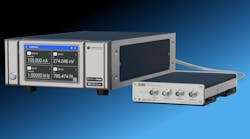SMU Optimized for Testing Nano/2D Semiconductor Devices
What you'll learn:
- How shrinking devices create test challenges.
- The first SMU with both AC and DC sourcing and measurement capabilities.
- How the solution can address the latest Nano/2D semiconductor devices.
Advanced semiconductor devices continue to shrink and operate at ever-lower signal levels, making it more difficult to validate and qualify devices. This is especially the case with the latest devices made with next-generation nanoscale materials. Addressing this situation, Lake Shore Cryotronics introduced a test instrument optimized for characterizing nanoscale and other low-power semiconductor devices.
The SMU-10 Source Measure Unit expands the module offering of Lake Shore’s MeasureReady M81-SSM Synchronous Source Measure (SSM) System, enabling users to easily source and measure signals that would otherwise be drowned out by electrical noise.
The M81-SSM system combined with the SMU-10 module targets low-power test applications with challenging signal-to-noise ratios. Other potential applications include I-V characterization of transistors used in specialized sensors, nanoelectromechanical systems (NEMS), quantum-computer readout electronics, and emerging specialized and integrated-circuit nanoscale semiconductor-based devices.
Manufacturers have continually been shrinking the feature size of semiconductor devices, with each successive generation characterized by reduced voltage, current, and power levels as well as correspondingly lower signal levels. Testing these advanced devices requires sourcing and measuring at extremely low levels. This presents signal interference challenges, with background electrical ambient and test setup-induced noise that can be often greater than the signals of interest.
The M81-SSM system uses low-noise-optimized source technologies along with highly sensitive and selective measurement capabilities leveraging synchronous AC detection methods and advanced filtering to tackle these issues.
Avoiding Noise While Extracting Small Usable Signals
To avoid noise and extract very small usable signals, the M81-SSM system uses frequency and phase-sensitive lock-in amplifier technology, with the source signal set for AC at a user-determined amplitude and reference frequency. The measurement processor “locks in” on just those signals while ignoring any other offsets and noise signals not at the specified reference frequency.
The M81-SSM system with the new SMU-10 module is the first I-V characterization system to combine both AC and DC capabilities with synchronous AC detection measurements.
With a maximum signal bandwidth of up to 100 kHz (I-range dependent), it allows for testing across a wide range of user-selectable frequencies (and DC), significantly reducing the stimulus signal power applied to devices. As a result, it helps eliminate unwanted thermal effects that could alter the device’s baseline characteristics.
A user can easily switch between or combine DC and/or AC measurement modes without changing the physical setup. It performs measurements with very low source and measurement noise with sensitivities below 10 nV/√Hz (AC) and below 100 fA (DC) with maximum voltage/current levels of ±10 V and ±100 mA DC/peak.
The M81-SSM system and SMU module’s source noise performance is several orders of magnitude below that of conventional DC SMUs—measurement sensitivity reaches down to tens of nanovolts. The SMU-10 module is a purely analog module without high-speed digital circuitry and the accompanying high-frequency noise. It's physically remote from the M81-SSM instrument, which houses all of the high-speed digital processing and data-converter circuitry.
The modular architecture enables the signal amplifier modules to be located very close to the device under test using the shortest possible signal-level test leads. This minimizes the ambient, power-line, and machine noise that could otherwise be coupled into, and contaminate, the desired low-level signals of interest.
When using multiple SMU-10 modules or in combination with other types of M81-SSM modules, the M81-SSM instrument employs the company's MeasureSync technology to synchronously sample all source outputs and measure inputs at 375 ksamples/s. This leads to tightly synchronized data collection and eliminates data misalignment errors.
It also facilitates accurate timing control for pulsed I-V and other time-dependent measurements, as well as compensates for phase shifts caused by parasitic cable capacitance to present a more accurate resistance measurement.


